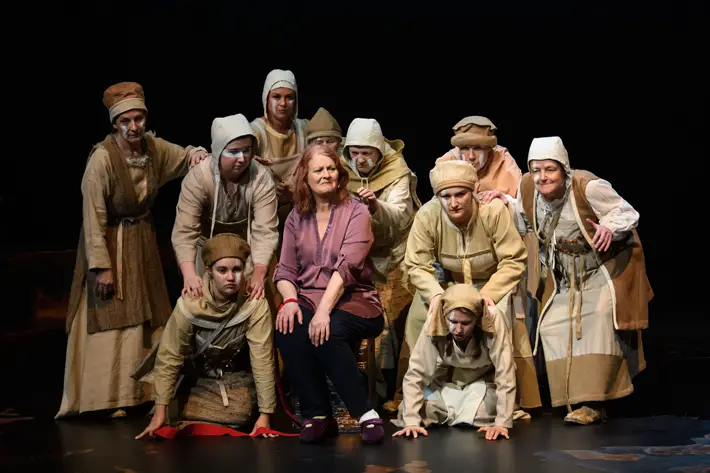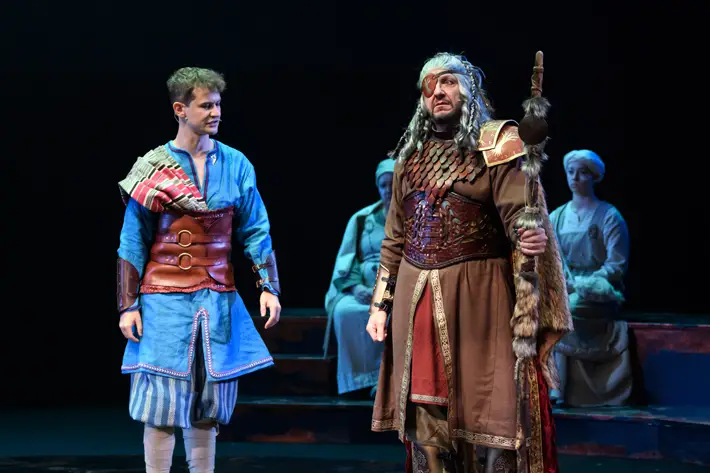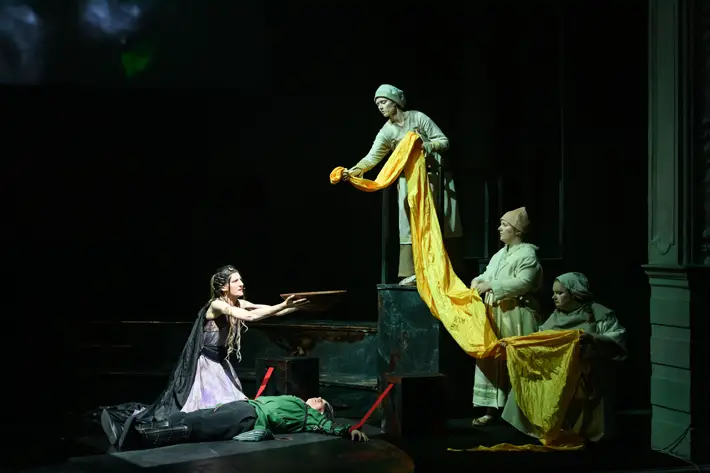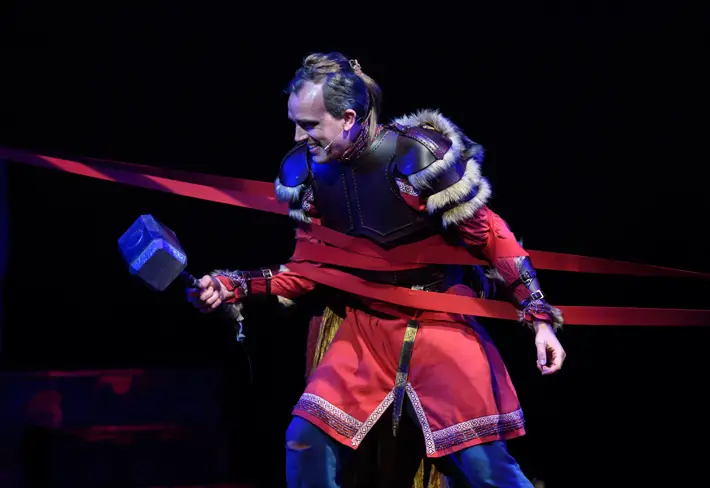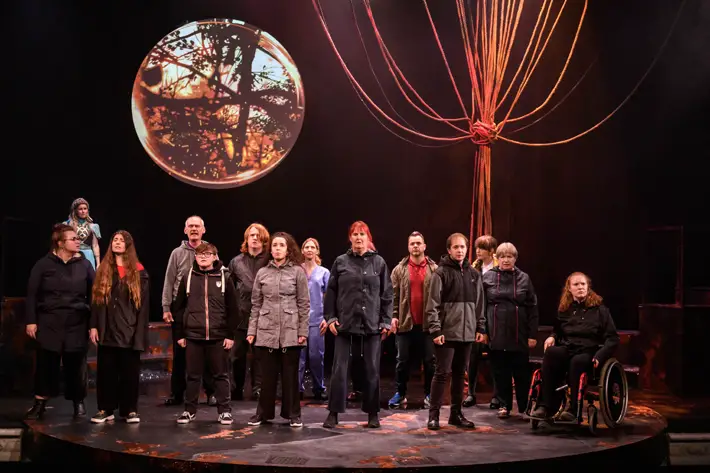The Coppergate Woman – Review – York Theatre Royal
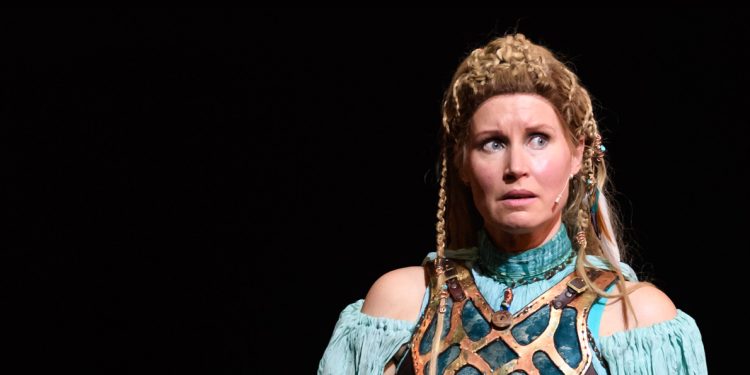
By Elizabeth Stanforth-Sharpe, August 2022
The publicity surrounding The Coppergate Woman has touted York Theatre Royal’s long association with community theatre. Technically, that is true. York Theatre Royal has a proven track record of producing huge, glamorous, and truly brilliant, high profile shows that involve both professional actors and community participants in complete synergy with each other. Some of those productions have been done in promenade, some have revolved around inspiring landmarks of the city, some have seen a number of those community casts go on to fulfilling professional careers, and some have had incredible ongoing projects emerge from them, but it is fair to say that all were created during the tenure of a very different theatre profile than the one that is in place today. The Chief Executive has changed, in place of an Artistic Director there is now a Creative Director – a disparate entity, and the make-up of the tried and tested, and very accomplished, team of professional creatives that carried through each of those productions has completely gone. It is wrong to lay claim to another battalion’s victories, and to make connections with what has gone before is misleading.
The Coppergate Woman is York Theatre Royal creating a new community production with an almost clean slate – the only ‘remainers’ are Juliet Forster and John R Wilkinson (co-directors on this), with Sara Perks brought in as Set Designer, in a theatrical landscape that is profoundly different to the one that existed in pre-pandemic days.
York has a rich seam of Community Theatre running through it that may have begun in medieval times with the Mystery Plays but has been embraced wholeheartedly by the city ever since and is an incredible lever for personal and collective empowerment. It’s an artistic form that, from the writing of the script to putting the play on stage, requires knowledge and skill in group dynamics and processes of personal and community change, usually taking its inspiration from something within the community itself, whether it be geographical, historical or functional, and it relies on partnership rules between the director(s) and the participants. The Coppergate Woman is written by Hull playwright Maureen Lennon, an Associate Artist of Middle Child Theatre, whose impressive portfolio to date has shown a good understanding of the importance of place and personal experience.
“Imaginative”
The inspiration is found in two community realities. The first is historical; the remains of a Viking woman which are displayed in the city’s JORVIK Viking Centre. The second is factual; the tremendous tolls of loneliness, mental health issues, barriers to communication, suppressed grief, and separation from loved ones, that living through a prolonged lockdown took on so many, not only in York, but universally. To tie these two narratives together, Lennon draws upon the myths of the Norse gods. It’s an interesting, intelligent and ambitious concept that works well. As a piece of storytelling it is sound, but when approached to write the piece, Lennon was asked to provide a script that would have a Gig Theatre vibe to it which she is well qualified to do, and has executed well in previous collaborations, but somehow it fell short here; something that I don’t in any way think was her fault, but appears to have been a directorial misunderstanding of the genre task they had set her.
Gig-Theatre is the storytelling, the beat and the music working in harmony with, and responsive to, the reactions of each individual audience, that changes from performance to performance, but always allows room for interaction and play of a kind that isn’t found in an ordinary musical theatre show. The Coppergate Woman doesn’t come close to a Gig-Theatre vibe; one acoustic guitarist at the end of the show, a bit of audience clapping, and a splash of R.E.M.’s ‘It’s The End Of The World’ doesn’t quite hit that mark. That said, it IS a solid, imaginative piece of musical theatre, that utilises direct address in parts, with words by Lennon, and musical composition and direction by Nicolas Lewis.
Lennon imagines the Coppergate woman breaking free from her display box, and revealing herself to be a Valkyrie; a servant of Odin (Paul Mayo Mason) who was sent to the battlefields to choose the slain who were worthy of a place in Valhalla, the palace of Odin, where they would feast and drink until the Ragnarök, when they would march out to fight at the side of Odin, slaying the giants and releasing the world into a glorious new beginning. Valkyries wore breastplates and were understood to be able to fly and have supernatural powers.
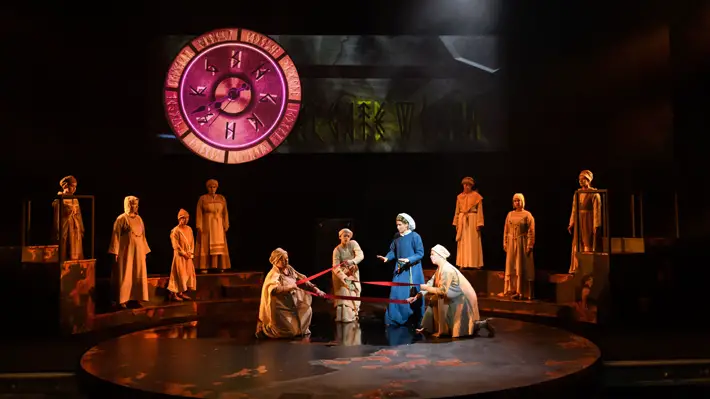
The Coppergate Woman (Kate Hampson), Was (Rosy Rowley), Being (Freya Popplewell), Shall Be (Vanessa McDougall)
“Unforeseen killer”
The Valkyrie has returned to help those who are wearied from their own battles of fatigue, loneliness and loss, accompanied by Norns; beings who created and controlled fate. The Principal Norns are named ‘Was’, ‘Being’ and ‘Shall Be’, ethereally played by Rosy Rowley, Freya Popplewell and Vanessa McDougal, who travel with the Coppergate woman through four vignettes interspersed with myths.
Baldr (played by Andy Williams) known for his light, wisdom and courage was universally loved, but had a dream that he was going to die. His mother Frigg (Jessica Murray) extracted a promise from all living beings that nothing would harm him, and the gods amused themselves by throwing objects at him, believing he was immune from destruction, but Frigg had overlooked one tiny plant, thinking it too young to bother him. The blind god Höd, Baldrs own brother, deceived by the evil Loki (played with suitable sinister menace by Edward Hammond), threw a spear fashioned from mistletoe at Baldr which killed him with its poison.
Who could have known that an unforeseen killer was to be hurled at the wintry world of November 2019?
Fern (Joanne Rule), a clinically vulnerable person, had lost contact with her social groups, became afraid to go outside and, in her increasing loneliness, sniped ferociously at her neighbours through the windows of a home that had become a prison. Her fate was controlled by her own Norns – Katie Clark, Andrea Cundell, Victoria Delaney, Iona Dowling, Claire Kennard, Shirley Kenyon, Kiki Maya, Lucinda Rennison, Eleanor Royse and Jen Tovey.
“Gods were outraged”
Fenrir, the monstrous wolf of Norse mythology, and son of the demonic Loki, was beautifully articulated by Livy Potter, Jack Lowes and Millie Boyes, roaming the stage dangerously, and gnashing savage teeth. Fearing his strength and his capacity for evil, Tyr (James Ward), the god of war and bloodshed, but also known as a bringer of order and justice, distracted the beast, allowing it to bite off his own arm, so that the gods might bind Fenrir with a magical chain, said to be formed from the sound of a cat’s footsteps, the beard of a woman and the breath of a fish. Fenrir was destined to remain until Ragnarök, fastened to a rock, with a sword gagging his mouth.
Sarah (Nicola Wild) was a nurse and a single mum, dedicated to her job, exhausted by the long shifts of nursing people throughout the pandemic, trying to juggle work with caring for a child, and not really having had the time to process or acknowledge any depth of grief for her mother who had died during lockdown. Sarah’s Norns are Christie Barnes, Saskia Bindloss, Christine Bramwell, Sarah Davies, Beth Rose Edwards, Celeste North Finnochi, Caroline Fleming, Stephanie Hesp, Charlie Johnson, Rosalind Reynolds, Scarlett Rowley, Jessica Leanne Smith, Kit Taylor and Caroline Walmsley.
There’s a lovely unspoken serendipity in the casting of Catherine Edge as Sigyn, the second wife of Loki. Sigyn was from Aesir giant descent. Edge is beautiful, dignified and elegantly tall. When the much loved Baldr was killed, the gods were outraged and everyone close to Loki was punished. Sigyn and Loki had two sons, Vali and Narfi. Vali was turned into a wolf, who then tore the body of Narfi apart. The gods pulled out the intestines of Narfi and made them into a chain. Loki was taken into a cave deep in the core of the earth and bound with those chains made from his son’s entrails. A snake was placed over his head to dribble a continual stream of painful venom down his face.
“Symbol of inner peace”
It’s a tale that builds like ‘The House That Jack Built’, one sorrow leading to another and then another worse than the one before, but then, who knew that a few ill people would escalate into deaths, comas, isolation wards, images of communal graves and hastily wrapped bodies across the world, and who knew that medics, nurses and health structures would be bowed and broken through the constant battle to stem the damage?
Sigyn, despite all she had lost, stayed faithful to Loki, by his side when he was chained with her own child’s remains, and holding a bowl to catch the snake’s venom. When the bowl became full, she had to leave the cave for a few moments to empty its contents, and whilst she was away, the venom would drop on his head, causing him to cry out in agony and trembling. His suffering was said to be the origin of earthquakes. Sigyn came to be revered by the Vikings, and became the goddess of fidelity, nurturing and grieving, a symbol of inner peace and a reminder that it isn’t always necessary to be a strong warrior to bring about change; sometimes it is enough to just be there.
Tom (Darren Barrott) had always been a strong man physically. He had worked out, boxed and kept himself fit, thinking himself able to cope with any situation. He hadn’t envisaged a time when the gym would be shut, and his much-loved brother would be lying in a hospital bed for months on end, the coma brought about through an illness that all the boxing in the world couldn’t protect him from. For a long time, he hadn’t been able to visit, and when he could the fears stacked up, causing him to beat out his frustrations on the bricks of a hospital building he was too scared to enter. Tom’s Norns are Gary Bateson, Jonathan Cook, Peter Gay, Liam Godfrey, Mark Gowland, Jack Lowers and Piergiuseppe Parisi.
After Baldr’s death, the messenger Hermod (Joe Hopper) was sent to Hel (Amelia Fordyce), the goddess of the land of the dead, to ask for Baldr’s return to life because he was loved by all the world. Hel asked for proof of this statement; that the tears of every creature on earth be presented to him. All did weep, except for one giantess Thökk, who was really Loki in disguise, so Baldr’s death was set to remain until he was brought to life again at Ragnarök as the ruler of a new peaceful realm.
“So much packed into this”
No matter how many tears are shed, and how deep the grief, the dead remain lost to us, and we must find a path to negotiate a life without them.
Liv (Ilya Cuthell and Hannah Sampson share the role) has had a great many things for her young mind to deal with. A mum who is always busy, always tired and always too frazzled for listening, stories and play, isolation from her schoolfriends during lockdown, being able to only wave to her Nana (Val Burgess) through a window, and then learning that she has died during the long separation, and a neighbour who shouts at her for playing outside. She needs her mum and longs for her Nana’s hugs. Liv’s Norns are Millie Boyes, Marie-Louise Feeley, Celeste North Finnochi, Clare Halliday, Richard Hampton, Billy Heathwood, Jayne Jack, Nick Jackson, Natalia Alicia Mercedes Littlemore, Andrea Mitchell, Anna Mogyorosy, Richard Sheils, and Suzanne Simpson.
The Coppergate Woman has her own story to add into the mix. Her husband had died of a fever, she was afraid that she too would succumb to the illness but remained well, only to become isolated when she needed comfort, shunned by a society who feared she might carry the infection. She had learned to find a pathway through the pain. Hers was a reflection that showed the circularity of history; that throughout the ages there have been plagues and diseases, lockdowns, isolations, fears and griefs, and that life holds no guarantees of safety or protection.
Liv’s connection to the Coppergate woman is different; she emerges as a modern day Valkyrie, able to fly, and able to hear the horn of Heimdall (Alexander Mayes), the watchman of the gods, heralding Ragnarök, when giants and gods will come from all points of the compass for a mighty battle, when Loki is killed, the sun will darken, the stars disappear, the Rainbow bridge that connects the world of the gods with the world of humans will collapse, and the earth will be destroyed. Then, Baldr will return from the dead, those remaining will live in peace, and life and vitality will flow from the world tree. It is Liv that throws the stars into the skies of a new way of living. Fern ventures out of her home and finds her place in society again, Sarah realises her own well-being and that of her daughter is important, Tom finds the courage to visit his brother, and all help each other to adjust to a ‘new normal’, but it’s important to add that it’s a new beginning that doesn’t hold any promises that there won’t be more jagged edges to come.
There is so much packed into this script, and it is so intelligently perceived, but some parts worked in production and some didn’t. Lennon is a talented writer; that she is a writer of Community Theatre I’m not yet convinced.
“Gracious and generous”
The community cast were wonderful, their enthusiasm present throughout, and there were stand out performances from Ilya Cuthell (Liv), Andrew Isherwood (Thor), Amelia Fordyce (Hel) and Nicola Wild (Sarah). Kate Hampson (the Coppergate woman), as the only professional in the cast, was so gracious and generous in her presence there; it was lovely to watch.
The stage set was a Facebook header, with changing projections in the cover picture and the profile picture roundel. Vikings believed that the world was a circular disk which contained the tree of life, so for the myth parts, the images were of leaves and branches, but changed to show various Covid images, the shattering of the display box at Jorvik, street signs and more, culminating in a spectrum of the colours of the Rainbow Bridge. Part way through, I forgot to look at what was there, and I’m not sure what I made of the concept. Presumably it was trying to convey something of how internet communications helped to connect people during lockdown?
The Norns wove the web of fate, and this was illustrated by a red band that was ingeniously used to form doorways, a gym, a grave, cords to bind a wolf and numerous other things. Several cultures have stories of scarlet threads that connect all humans throughout history, so this visual worked well.
There was also a beautiful moment when ropes formed the tree of life, and the casting of the stars was pretty.
My main concern, however, was that there were so many people packed on the stage at some moments, for the most part on one level, that it looked as though, rather than the actors owning the stage, the stage was crushing the actors. It appeared chaotic, clumsy and claustrophobic. Coupled with this, there were long periods of solo narrative that could have been shared between actors. The cast deserved better. One of the most vital parts of Community Theatre, backed up by solid blocks of research, is that it empowers the people involved, building confidence, self-esteem, interpersonal skills, friendships, self-efficacy and so much more. They have given freely of hours of their own time and invested so much, and they deserve the very best care and thought from the theatre (who, let’s face it, will be the ones who pick up the accolades). Let those gorgeous individuals have the space to shine and show what they are truly capable of.
‘The Coppergate Woman’ runs at York Theatre Royal until Sunday, August 7th.
images: Jane Hobson
